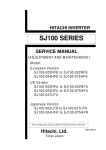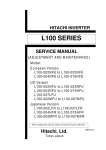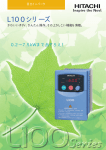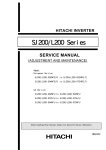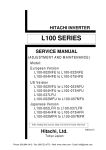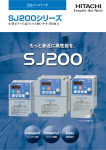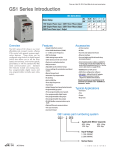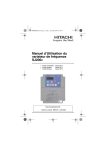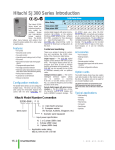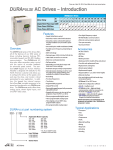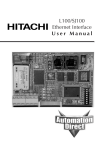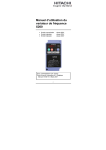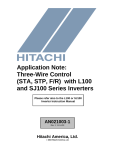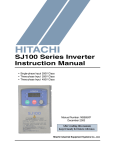Download Hitachi SJ100 Inverter - Artisan Technology Group
Transcript
Looking for more information? Visit us on the web at http://www.artisan-scientific.com for more information: • Price Quotations • Drivers· Technical Specifications. Manuals and Documentation Artisan Scientific is You~ Source for: Quality New and Certified-Used/Pre:-awned ECJuiflment • Fast Shipping and DelIve1y • Tens of Thousands of In-Stock Items • Equipment Demos • Hundreds of Manufacturers Supported • Leasing / Monthly Rentals Service Center Repairs Experienced Engineers and Technicians on staff in our State-of-the-art Full-Service In-House Service Center Facility • Consignment InstraView Remote Inspection Remotely inspect equipment before purchasing with our Innovative InstraView-website at http://www.instraview.com We bUy used equipment! We also offer credit for Buy-Backs and Trade-Ins Sell your excess. underutilized. and idle used equipment. Contact one of our Customer Service Representatives todayl Talk to a live person: 88EM38-S0URCE fB88-887-68721 I Contact us by email: [email protected] I Visit our website: http://www.artisan-scientific.com HITACHI INVERTER SJ100 SERIES SERVICE MANUAL (ADJUSTMENT AND MAINTENANCE) Model: European Version SJ100-002NFE to SJ100-022NFE SJ100-004HFE to SJ100-075HFE US Version SJ100-002NFU to SJ100-022NFU SJ100-004HFU to SJ100-075HFU SJ100-037LFU Japanese Version SJ100-002LFR to SJ100-037LFR SJ100-004HFR to SJ100-075HFR After reading this manual, keep it at hand for future reference Hitachi, Ltd. Tokyo Japan NBS585XA INDEX 1-1 1. Pre-operation Check 1-1. Check inverter model and Manufacturing number 1-1 1-2. Check inverter parameter and motor specification 1-2 2. Measurement of The Internal Voltage Supply 2-1 3. Trouble Shoot 3-1 3-1. Error messages - Possible Cause and Remedy 3-1 3-2. Analysis of Various Operating Problems That Do Not Trigger an Trip Message 3-7 3-3. How to Initialize the Data (FACTORY SETTING) 3-8 3-4. Error Message Comparison 3-9 3-5. Other Displays 3-10 3-6. Auto tuning under high incoming voltage 3-10 4. Ambient Condition of the Frequency Inverter (Temperature, Altitude) 4-1 4-1. Required Derating in case of 50deg., 55 deg. of Ambient Temperature 4-1 4-2. Required derating toward altitude 4-4 5. Level of Each Detection 5-1 5-1. DC Bus Voltage Detection Characteristics 5-1 5.2. Output Current Detection Characteristics 5-3 5.3. Motor Temperature Detection (PTC) 5-4 5.4. Over Temperature Detection of the Frequency Inverter 5-4 6. Measurement & Replacement of Subassemblies 6-1 6-1. Insulation Measurement 6-1 6-2. Power Components Measurements 6-1 7. Maintenance and Inspection Procedure 7-1 7-1. Precautions 7-1 7-2. Measurement of Mains Voltage, Current and Power 7-1 7-3. Maintenance of Parts 7-4 7-4. If you install replacement INV at site 7-4 8. Daily Inspection and Periodical Inspection 8-1 9. Image block diagram 9-1 10. Spare parts list 10-1 10-1. parts list 10-1 10-2. I/O board compatibility 10-3. O, OI terminal adjustment procedure (C81, C82) 10-13 10-14 10-4. kW 10-15 setup procedure 10-5. I/O board schematic (circuit diagram) - i - 10-16 Revisions Revision history table No. Revision contents Date of issue -ⅰⅰ- Manual No. 1. Pre-Operation Check Before starting adjustment and maintenance, be sure to check the following specifications of the inverter and the motor. 1.1 Check Inverter model and Manufacturing number (MFG No). Inverter model HITACHI Model : SJ100-015NFE HP/kW : 2 / 1.5 Input/Entree: 50,60Hz 200-240V 50,60Hz 200-240V Output/Sortie: 1-360Hz 200-240V MFG No. 78H T1129670060 MFG No. 1Ph 3Ph 3Ph Hitachi, Ltd. MADE IN JAPAN 16.0 A 9.3 A 7.1 A Date: 9708 NE16452-6 You can find these information from the specification label which attached at the side cover of the unit. (1) Description of the model name. SJ100 015 H F E Structure type F: With operator Series name Version number E: European version U: US version R: Japanese version Input voltage class N: Single/3 phase 200V class L: 3 phase 200V class H: 3 phase 400V class Applicable motor kW 002 : 0.2kW 022 004 : 0.4kW 030 005 : 0.55kW 037 040 007 : 0.75kW 011 : 1.1kW 055 015 : 1.5kW 075 : 2.2kW : 3.0kW : 3.7kW : 4.0kW : 5.5kW : 7.5kW (2) Description of MFG No. 7 8 H T112967 0060 Unique number Production code Revision of the inverter Production Month (1 - 9, 0:October, J:November, K:December) Production year (The unit digit of the year of grace. 7:1997, 8:1998, 9:1999, 0:2000) 1-1 1.2 Check Inverter parameter and motor specification. [1] Inverter specifications. (1) Inverter specifications (Monitor mode) Display order 1 2 3 4 5 6 7 8 9 Function name Output frequency monitor Output current monitor Running direction monitor Feedback data of PID control monitor Intelligent input terminal condition monitor Intelligent output terminal condition monitor Output frequency converted value monitor Trip monitor Trip history monitor Category Monitor Monitor Monitor Monitor Screen display Code display d01 d02 d03 d04 EU - Initial US - JPN - Remarks Monitor d05 - - - Monitor d06 - - - Monitor d07 - - - Monitor Monitor d08 d09 - - - Set Set Set Screen display Code display F01 F02 F202 EU 0.0 10 10 Initial US 0.0 10 10 JPN 0.0 10 10 Set Set F03 F203 10 10 10 10 10 10 Set Set F04 A-- 00 00 00 Set B-- Set C-- Set H-- (2) Inverter specifications (Basic function mode) Display Function name Order 1 Output frequency setting 2 Acceleration time 1 Acceleration time 1 (2nd setting) 3 Deceleration time 1 Deceleration time 1 (2nd setting) 4 Running direction setting 5 Extended function A group setting 6 Extended function B group setting 7 Extended function C group setting 8 Extended function H group setting Category Remarks Note; “-“ means hidden display ;depends on 2nd setting selection. (3) Inverter specifications (Extended function mode : A group) Displa Function name Category y Order 1 Frequency destination Set 2 Running command Set destination 3 Base frequency Set nd Base frequency(2 setting) Set 4 Maximum frequency Set Set Maximum frequency(2nd setting) 5 External freq. setting start Set 6 External freq. setting end Set 7 External freq. setting start Set rate 8 External freq. setting end Set rate 9 External freq. start pattern Set 10 Time constant of the filter Set of analog input Screen display Initial Remarks Code display A01 A02 EU 01 01 US 01 01 JPN 00 02 A03 A203 A04 A204 50 50 50 50 60 60 60 60 60 60 60 60 A11 A12 A13 0 0 0 0 0 0 0 0 0 A14 100 100 100 A15 A16 01 8 01 8 01 8 1-2 (3) Inverter specifications (Extended function mode : A group) Display Function name Order 11 Multi-speed 1 to 16 12 Jogging frequency 13 Stop mode of jogging Category Set Set Set Screen display Code display A20 - A35 A38 A39 EU 0 1.0 00 Initial US 0 1.0 00 JPN Note 1 1.0 00 Remarks Set A41 A241 00 00 00 00 00 00 Set A42 11 11 11 A242 11 11 11 A43 10.0 10.0 10.0 A243 10.0 10.0 10.0 Set A44 A244 00 00 00 00 00 00 18 Torque boost mode Torque boost mode(2nd setting) Level of manual torque boost Level of manual torque boost (2nd setting) Manual torque boost frequency Manual torque boost frequency (2nd setting) V/f characteristics V/f characteristics(2nd setting) V-gain Set A45 100 100 100 19 20 21 22 23 Selection of DC braking DC braking frequency DC braking waiting time DC braking force DC braking time Set Set Set Set Set A51 A52 A53 A54 A55 00 0.5 0.0 0 0.0 00 0.5 0.0 0 0.0 00 0.5 0.0 0 0.0 24 25 26 27 Frequency upper limiter Frequency lower limiter Jump frequency 1-3 Jump frequency width 1-3 Set Set Set Set A61 A62 A63, A65, A67 A64, A66, A68 0.0 0.0 0.0 0.5 0.0 0.0 0.0 0.5 0.0 0.0 0.0 0.5 28 29 30 31 32 Set Set Set Set Set A71 A72 A73 A74 A75 00 1.0 1.0 0.0 1.0 00 1.0 1.0 0.0 1.0 00 1.0 1.0 0.0 1.0 33 Selection of PID control P gain I gain D gain Scale conversion of PID control Feedback destination Set A76 00 00 00 34 35 Selection of AVR function AVR voltage Set Set A81 A82 02 230/400 02 230/460 02 200/400 36 - Second acceleration time Second acceleration time(2nd setting) Second deceleration time Second deceleration time(2nd setting) Method to use 2nd acceleration / deceleration (Acc2 / Dec2) Method to use 2nd acceleration / deceleration (Acc2 / Dec2)(2nd setting) Acc1 to Acc2 changing frequency Acc1 to Acc2 changing frequency(2nd setting) Dec1 to Dec2 changing frequency Dec1 to Dec2 changing frequency(2nd setting) Acceleration characteristic Deceleration characteristic Set A92 A292 15.0 15.0 15.0 15.0 15.0 15.0 Set A93 A293 15.0 15.0 15.0 15.0 15.0 15.0 Set A94 00 00 00 A294 00 00 00 A95 0.0 0.0 0.0 A295 0.0 0.0 0.0 A96 0.0 0.0 0.0 A296 0.0 0.0 0.0 A97 A98 00 00 00 00 00 00 14 15 16 17 - 37 38 - 39 40 41 42 Set Set Set Set Set Note 1; A20;0, A21;5, A22;10, A23;15,A24;20, A25;30, A26;40, A27;50, A28; 60,A29--A35;0 1-3 (4) Inverter specifications (Extended function mode : B group) Display Function name Order 1 Selection of restart mode 2 Allowable UV time 3 Retry waiting time Category Set Set Set Screen display Code display B01 B02 B03 EU 00 1.0 1.0 Initial US 00 1.0 1.0 JPN 00 1.0 1.0 Remarks 4 Electronic thermal level Set B12 note note note - Electronic thermal level (2nd setting) Electronic thermal characteristics Electronic thermal characteristics (2nd setting) Overload restriction operation mode Overload restriction level Set B212 note note note Set B13 01 01 00 Set B213 01 01 00 Set B21 01 01 01 Set B22 note note note Set B23 1.0 1.0 1.0 Set B31 01 01 01 Set Set Set Set B81 B82 B83 B84 80 0.5 5 00 80 0.5 5 00 80 0.5 12 00 Set Set B85 B86 01 1.0 02 1.0 00 1.0 Set Set B87 B88 00 00 00 00 00 00 Set B89 01 01 01 Set B90 00 00 00 Set Set B91 B92 00 00 00 00 00 00 5 6 7 8 9 10 11 12 13 14 15 16 17 18 19 20 21 Deceleration rate while overload restriction Selection of software lock Analog meter adjustment Start frequency adjustment Carrier frequency Data initialization or Trip history clear Initialization mode Frequency converting value STOP key condition Restart mode after FRS invalid Monitor contents for OPE-J Dynamic braking usage ratio Stopping mode selection Cooling fan control selection 1-4 Rated current of each inverter Rated current of each inverter Rated current * 1.25 for each inverter (5) Inverter specifications (Extended function mode : C group) Display Order 1 2 3 4 5 6 Input terminal 1 assign Input terminal 2 assign Input terminal 3 assign Input terminal 4 assign Input terminal 5 assign Input terminal 6 assign Set Set Set Set Set Set Screen display Code display C01 C02 C03 C04 C05 C06 7 8 9 10 11 12 Input terminal 1 condition Input terminal 2 condition Input terminal 3 condition Input terminal 4 condition Input terminal 5 condition Input terminal 6 condition Set Set Set Set Set Set C11 C12 C13 C14 C15 C16 00 00 00 00 00 00 00 00 00 01 00 00 00 00 00 00 00 00 13 14 15 16 Output terminal 11 assign Output terminal 12 assign FM terminal condition Function of AL terminal setting Output terminal 11 condition Output terminal 12 condition AL output terminal condition Level of overload signal Set Set set Set C21 C22 C23 C24 01 00 00 05 01 00 00 05 01 00 00 05 Set C31 00 00 00 Set C32 00 00 00 Set C33 01 01 01 Set C41 note note note Set C42 0.0 0.0 0.0 Set C43 0.0 0.0 0.0 Set C44 3.0 3.0 3.0 Set Set Set Set Set Set Set C81 C82 C91 C92 C93 C94 C95 --00 0000 -D0001 -- --00 0000 -D000 -- --00 0000 -D000 -- 17 18 19 20 21 22 23 24 25 26 27 28 29 30 Function name Arrival frequency while acceleration Arrival frequency while deceleration Level of deviation signal under PID control Analog input O adjustment Analog input OI adjustment Debug mode selection Core monitor address Core monitor data Core set address Core set data Category Note 1 USP function EU 00 01 02 03 18 09 Initial US 00 01 16 13 09 18 JPN 00 01 02 03 09 18 Remarks Note 1 Rated current of each inverter (NC) is allocated on US version and even another function such as CF1 is set, NO/NC parameter is still the same. Therefore, please make sure the NO/NC parameter to suit the application. 1-5 (6) Inverter specifications (Extended function mode : H group) Display Order 1 2 3 - 4 5 6 7 8 11 12 13 14 15 16 17 - Function name Auto tuning setting Motor data selection Motor data selection(2nd setting) Motor capacity setting Motor capacity setting(2nd setting) Motor poles setting Motor poles setting(2nd setting) Speed response setting Speed response setting(2nd setting) Motor stabilization constant setting Motor stabilization constant setting(2nd setting) Motor constant R1 setting Motor constant R1 setting(2nd setting) Motor constant R2 setting Motor constant R2 setting(2nd setting) Motor constant L setting Motor constant L setting(2nd setting) Motor constant Io setting Motor constant Io setting(2nd setting) Motor constant J setting Motor constant J setting(2nd setting) Motor constant R1(auto tuning data) Motor constant R1(auto tuning data,2nd setting Motor constant R2(auto tuning data) Motor constant R2(auto tuning data,2nd setting Motor constant L(auto tuning data) Motor constant L(auto tuning data,2nd setting Motor constant Io(auto tuning data) Motor constant Io(auto tuning data,2nd setting Motor constant J(auto tuning data) Motor constant J(auto tuning data,2nd setting Catego Screen display ry Code display Set H01 Set H02 Set H202 Initial Remarks EU 00 00 00 US 00 00 00 JPN 00 00 00 Set Set H03 H203 *3 *3 *3 *3 *3 *3 Set Set H04 H204 H05 H205 4 4 20 20 4 4 20 20 4 4 20 20 Set H06 100 100 100 Set H206 100 100 100 Set set H20 H220 *2 *2 *2 *2 *2 *2 Set Set H21 H221 *2 *2 *2 *2 *2 *2 Set H22 H220 *2 *2 *2 *2 *2 *2 H23 H223 *2 *2 *2 *2 *2 *2 Set H24 H224 *2 *2 *2 *2 *2 *2 *1 H30 *2 *2 *2 *1 H230 *2 *2 *2 *1 H31 *2 *2 *2 *1 H231 *2 *2 *2 *1 H32 *2 *2 *2 *1 H232 *2 *2 *2 *1 H33 *2 *2 *2 *1 H233 *2 *2 *2 *1 H34 *2 *2 *2 *1 H234 *2 *2 *2 *1; don’t change the data *2 ; factory set *3 ; specified by the capacity of each inverter 1-6 [2] Motor specifications. Output voltage V Output frequency 0 Hz Hz Motor MFG number Motor output kW Rated current Amps Motor poles p Rated voltage V Motor rated rpm rpm Rated frequency Hz Starting current Amps Acceleration time sec sec [3] Load conditions Equipment name Torque characteristics Required torque Nm Deceleration time Load inertia (J) kgm2 Variable speed range Hz 1-7/E to Hz 2. Measurement of the Internal Voltage Supply There are PV5L, PV24L and NV12L internal DC voltage supplies. These supplies are isolated from the main high voltage portion. And it is not possible to measure DC voltages at the non isolated portion. Please make measurements for above mentioned voltages for the isolated portion. Check pad of NV12 Check pad of PV24 Check pad of PV5 1 pin of TM2 is “L”common PV5L supply voltage Supplies 5V for I/O board. Nominal voltage : min. 4.90Vdc to max. 5.20Vdc Check PV5(address 1C) <- L PV24L supply voltage Supplies 24V to interface voltage supply, which is supplied to input terminals. Nominal voltage : min. 21.60Vdc to max. 26.40Vdc Check PV24(address 1A) <- L NV12L supply voltage Supplies -12Vdc to remote operator (DOP/DRW’s yellow back light ). Nominal voltage : max. -10.80Vdc to min. -17.5Vdc Check NV12(address 3A) <- L “H” terminal voltage Suppiles 10V to “H” terminal Nominal voltage : min 9.5Vdc to max 11.5Vdc Check “H” <-> “L” with VR (1kohm) “Potentiometer function on the front case Set “A01” :”00” Monitor “F01” display 0 <-> 50(60) with clockwise and anti clockwise. Cooling FAN voltage (PV24N) Supplies 24V to cooling FAN . Nominal voltage min 19.9Vdc to max 27.2Vdc. Check Red wire <- Black wire with the FAN. Check the FAN working, direction(from down to up). 2-1/E 3. Trouble Shoot 3-1. Error Messages - Possible Cause and Remedy: (1) Over current 1 (E 01, E 02, E 03, E 04) Phenomena: Over current (CT or Rsh;gate driver IC) for each condition. E 01 : Over current during constant speed operation. E 02 : Over current during deceleration. E 03 : Over current during acceleration. E 04 : Over current at other condition than above mentioned. (such as injection brake) Cause: Remedy: Load changed rapidly. Eliminate rapid changed in load. Cause: Remedy: Sort circuit or earth contact (ground fault) in the motor or the motor cable. Check with Megger. If the motor cable is disconnected from the inverter, the over current should not be detected anymore. Cause: Remedy: A single-phase power failure (fuse, wire, ...) can cause a shutdown in certain under load situations.. Check all these mains phases and the mains fuses, preferably by comparison of the three (two in case of single phase inverter) mains currents in a steady operating state. Cause: Remedy: The motor is switched with a motor contactor during frequency inverter operation. Switching over the motor is inhibited. Cause: Remedy: Defect in the power component. Check the IGBT portion of ISPM. Cause: Remedy: Rapid acceleration or deceleration. Set suitable acceleration or deceleration time. Cause: Remedy: Starting frequency is too high. Set starting frequency as low as possible. Way to Reset: A SJ100 has two kinds of detection; CT and Rsh. To resolve the detection at site, check the following procedure. 1. Connect DOP/DRW. 2. Set F38 INIT DEBG ON. (to access debug mode) 3. Set F22 IPS POWR ALM mode, don’t set retry mode. 4. Test run and wait Over Current trip. 5. Set Core address “FBE4” if it’s 4kW or less. 5. Set Core address “FBE2” if it’s 5.5kW or above. 3-1 Specimen ; “CO FBE4 01 0000” ; under normal; 0Hz “CO FBE4 15 0203” ; under over.C trip “CO FBE4 15 C203” ; under OC.Drive trip. “CO FBE4 15 4103” ; under OC.Accel trip “FBE4” or “FBE2” is 1 byte data, the data is hex data. Example “4103”; “03” has no meaning. Resolve “41”h bit by bit, “41”h -> “0100 0001”b if you found “xxxx xxx1” ; this means Over current detection from CT (CTU or CTW) if you found “xxxx xx1x” ; this means Over current detection from Rsh Standard operator is not available on this trouble shooting. (2) Overload (E 05) Phenomena: Overload (detected by CT) of the inverter. This error can be reset 10 seconds after the E05 came out. Cause: Remedy: Motor load is heavy. Reduce the load and/or increase thermal level and/or use bigger capacity of frequency inverter. Cause: Remedy: V-Boost value is high. Reduce V-Boost value or increase thermal level and/or use bigger capacity of frequency inverter. Cause: Set wrong value for electronic thermal level [b12] and/or electronic thermal characteristic [b13]. Set suitable value. Remedy: Cause: Remedy: Set wrong value for the reactive current of the motor. Set suitable value. Reactive current value which should be input by function mode is a value measured at 50Hz (60Hz) without load. Way to Reset: A (3) Braking Resistor Overload (over voltage) (E 06) Phenomena: Over Voltage detection after BRD%ED was run out. Cause: Remedy: BRD selection is not suitable. Check BRD %ED, BRD resistor ohm, BRD resistor Wattage, BRD resistor wire, machine inertial, operation cycle. Way to Reset: A 3-2 (4) Over voltage (E 07) Phenomena: Over voltage at DC bus line of the frequency inverter. Cause: Mains voltage too high, mains voltage fluctuation or rapid mains voltage return (choke energy leads to voltage increase). Make sure that mains voltage is within tolerance limits. Remedy: Cause: Remedy: Cause: Remedy: In case SJ100 is used in combination with a regenerative braking unit(ISPM)/ resistor but the regenerative braking unit(ISPM)/resistor does not function. Replace regenerative braking unit(ISPM)/resistor. In case SJU100 is used in combination with a raking resistor but the braking resistor cannot absorb the regenerative energy. Re-calculate and use suitable braking resistor. Cause: Remedy: Deceleration time is too short. Make deceleration time longer, use braking unit (resistor), use bigger capacity of frequency inverter. Way to Reset: A (5) Under voltage (E 09) Phenomena: Under voltage at DC bus line of the frequency inverter. Cause: Remedy: The mains voltage is not available or not within the tolerance limits. Check all 3 (or 2) mains power supply voltage that it is within its specification. Cause: Thyristor for smooth charging is defect and DC bus voltage drops while operation due to current flows through smooth charging resistor. Change ISPM. Period of instantaneous power failure is longer than the set value [b02], or DC bus voltage go down to its detecting level while instantaneous power failure. Get rid of the instantaneous power failure, evaluate the power supply system, set bigger value for [b02]. Remedy: Cause: Remedy: Cause: Remedy: One of the AC voltage is missing (applied only for 3 phase INV) Check AC line voltage , check the fuses. Way to Reset: A (6) EEPROM error (E 08) Phenomena: Abnormal situation occurs at the memory portion of the frequency inverter due to incoming noise etc.. Cause: Remedy: Influenced by Electrical Magnetic Interference. Keep such noise source away from the frequency inverter. Cause: Remedy: Ambient temperature is too high. Take countermeasure against high ambient temperature. 3-3 Cause: Remedy: Re-power up the frequency inverter short time after power off. It is necessary to keep several seconds after power off to memorize the current data at EEPROM. If this time is too short, this storage performance cannot be done and leads to EEPROM error. Keep certain time between power off and re-power up. Cause: Remedy: You didn’t wait 6 seconds or more at FACTORY SETTING. Please try FACTORY SETTING again. Cause: RS terminal was keeping “ON” at power off. (If RS is on, INV can not write the correct data to EPROM at power off, next power on E08 will come out.) Please don’t use “RS” terminal “ON” at power off. Remedy: Cause: EEPROM is defect. Remedy: Change unit. After you reset the INV, please make sure the parameters especially maximum freq. / Acc /Dec time / Low limit freq. to prevent any damage. Way to Reset: A or Power off (7) CT error (E 10) Phenomena: When abnormality noise is near the INV or an abnormality (offset level is out of spec.) occurs on built in CT. Cause: Remedy: Influenced by Electrical Magnetic Interference. (such as near contactor on/off) To Resolve if it’s influence, use another power line and don’t connect motor wires, control wires. If no error comes out, resolve noise causes. Cause: Remedy: CT offset level failure To Resolve if it’s failure, use another power line and power on and check if E10 comes out at power on. If E10 came out , use (replace) another INV(ISPM). Way to Reset: A or Power off (8) CPU error (E 11, E 22) Phenomena: Abnormal situation or malfunction of micro processor inside frequency inverter. E 11 : CPU error from MCU inside core. E 22 : CPU error from MCU on I/O board. E22 is produced by MCU on I/O board and the causes is communication error between ISPM & MCU on I/O board. Cause: Remedy: Cable (between ISPM and I/O board)was cut. (E22) Replace the cable. Cause: Remedy: Dusts on the pins of CN2 on I/O board. (E22) Remove the dusts. Cause: Remedy: Influenced by Electrical Magnetic Interference. Keep such noise source away from the frequency inverter. Cause: Remedy: Ambient temperature is too high. Take countermeasure against high ambient temperature. 3-4 Cause: Remedy: Component itself is defect. Replace ISPM (in case of E 11) or I/O board board (in case of E 12). (9) External Trip (E 12) Phenomena: Trip due to have inputted an external signal to “EXT” input terminal of the frequency inverter. Cause: Remedy: Faulty external device or equipment gives frequency inverter a trip requirement when external trip function (EXT) is selected. Evaluate external device or equipment which is connected to frequency inverter. Way to Reset: A (10) USP error (E 13) Phenomena: Unexpected Start Protection. This error can occur when “USP” function is selected. Cause: Remedy: Frequency inverter trips when it is powered up with RUN command is given. Disable RUN command when power up the frequency inverter. Or disable USP function if possible to the system. Way to Reset: A or set RUN command off (stop) (11) Ground fault error (E 14) Phenomena: Earth contact in the motor or the motor cable or in the IGBT. Frequency inverter detects this earth contact only at power up. To resolve the causes , please power off and disconnect the motor wire at INV (UVW)terminal. Cause: Remedy: Earth contact in the motor or the motor cable. Check the impedance between output portion(wire and motor) and earth. Cause: Detection circuit/IGBT of the inverter is defect. If the motor and the motor cable is disconnected from the frequency inverter, the ground fault should not be detected anymore. Please disconnect the motor and the motor cable. If E14 comes out at power on, please replace the unit. Remedy: Way to Reset: Don’t reset. (12) Over voltage at source (E 15) Phenomena: High voltage at power source line. Frequency inverter cannot protect source over voltage. If it is too high, frequency inverter will be damaged. Cause: Remedy: Source voltage is too high. Check the source voltage continously. Insert AC reactor at source lines. Way to Reset: A 3-5 (13) Over temperature (E 21) Phenomena: Temperature sensor which located close to IGBT inside ISPM shows a too high temperature. Cause: Remedy: Ventilator blocked. (for models which has ventilator.) Check ventilator Cause: Remedy: The frequency inverter does not get enough cooling air. Check cabinet ventilation, air filters, and ventilation openings in the cabinet. Way to Reset: A (14) PTC error (E 35) Phenomena: Resistance of motor thermistor is high. This error can occur when you select “PTC” function. Cause: Remedy: Too much load of the motor. Reduce the load, use bigger motor. Cause: Remedy: Motor thermistor is not connected while PTC function is selected. Disable PTC function when it is not used. Cause: Characteristics of the motor thermistor is not suitable. Frequency inverter gives PTC error when the resistance value becomes more than 3k ohm +-10%. Use motor which has suitable thermistor for the inverter. Or change thermistor characteristics of the thermistor by debug mode. Remedy: Way to Reset: A Explanation of the way to reset. A : Make close the terminals between RS and P24 (CM1 only for Japanese version) on the I/O board, or press “STOP/RESET” key of the operator. 3-6 3-2. Analysis of Various Operating Problems That Do Not Trigger an Trip message. Problem The motor does not start Possible cause Remedy Mode of frequency command [A01] Check each mode again and/or Run command [A02] is not proper Incorrect power supply condition Check that the power supply is within its specification Inverter is in trip mode Get rid of the trip cause 0 Hz of Multi-stage speed is given FRS and/or RS is remaining Make FRS and RS invalid 0 Hz command is given Each phase to phase voltage does Replace the unit not balance. (out of +-3%) Load is too heavy Decrease the load or use bigger capacity of inverter and motor Set as follows If you use DOP or DRW, DIP switch selection of the operator is 1 2 3 4 incorrect. ON OFF Rotation direction is opposite Motor does not increase speed The inverter cannot be programmed Unstable rotation of the motor Inverter Failure Wiring of the motor cable is incorrect (U, V, W) Setting of [F04] is incorrect Motor load is too heavy (Overload limitation) External frequency set (VR) is out of order Frequency limiter [A61] is set Acceleration time is too short Software lock is selected [b31] While INV running RS or FRS command is given Multi stage speed command is given Loose connection of DOP/DRW Inverter is in trip mode Motor load is changing heavily Data is not changed Source voltage is changing Mechanical resonance Forgot to press [STR] key Cannot change data by Copy Unit Turn main power off within 6 seconds after pressing [STR] key Turn power off within 6 seconds after started copying 3-7 Same as J300, J100,L100 Replace the unit Check the wiring of the motor cable Check the setting Remove or decrease the motor load replace VR Eliminate frequency limiter Set longer acceleration time Make software lock invalid Stop the INV Make them invalid Make inverter in stop mode Connect DOP/DRW properly Reset the inverter Reduce the motor load changing or use bigger capacity of inverter and motor Reduce the changing Change output frequency Press [STR] key after changing data Make sure to wait at least 6 seconds after [STR] key is pressed Make sure to wait at least 6 seconds 3-3. How to Initialize the Data (FACTORY SETTING) 1. Select the mode of initialization data to which you want to initialize by [b85]. Japanese version data -----> Set “00” and store EU version data -----> Set “01” and store US version data -----> Set “02” and store 2. Set [b84] to “01” to initialize and store. 3. Keep pressing FUNC. 1 2 keys at the same time. (If front case is not closed by the screw, difficult to press 3keys.) 4. Additionally press 5. Keep pressing STOP RESET FUNC. 1 key and release 2 STOP RESET key approximately after one second. keys until “d 00” will blink. (Approximately 2 seconds.) 6. Release all the keys after starts blinking. Initialization end FUNC. ON (press) 1 ON 2 ON STOP RESET ON 1s or more Release after “d 00” started blinking [c95] ; INV kW code 01;0.2kW , 02;0.4kW , 03;0.75kW (0.5 kW) , 04;1.5kW , 05;2.2kW , 06;3.7kW(4.0kW) , 07;5.5kW, 08;7.5kW 3-8 3-4. Error Message comparison Digital Panel DOP / DRW OC. OC. OC. Drive Over current while deceleration (CT or gate driver IC) Decel Over current while acceleration (CT or gate driver IC) Accel Over. C Over. L OL. Contents Over current while constant speed driving (CT or gate driver IC) Over current at other condition than above(such as 0Hz,injection brake) (CT or gate driver IC) Over load (Possible to reset after 10 seconds has passed, detected by CT) Over voltage after the BRD%ED was run out. (DC bus) BRD Over. Over voltage (DC bus) V EEPROM error (Check the parameters again if this error occurred) Under voltage (DC bus) EEPROM Under. V CT offset error such as external noise or CT itself CT CPU error CPU 1 CPU 2 External error External USP error USP GND OV. OH Ground fault at power-on detected by CT Flt Over voltage at source (DC bus) (continuously 100sec while stop) SRC Over temperature (in the ISPM) FIN PTC error (only terminal 5 ) PTC 3-9 3-5. Other Displays Digital Panel Contents - Reset terminal is ON - During initialization (such as at power-on) - Voltage is within UV level - Power OFF - During retry mode - During initialization as EU settings - During initialization as US settings - During initialization as Japanese settings - Erasing trip histories - Copying with DRW,DRW-2 - When there is no data (i.g. feedback data of PID, etc.) Auto tuning was done. Auto tuning was failed. 3-6. Auto tuning under high incoming voltage If Auto tuning is not successful , try following procedure. 1. Set C91 “01” and press STR key. (to access debug mode) 2. Set H01 “01” and press STR key. (to do auto tuning) 3. If the SJ100 is 4kW or less, set C94 “fb82” and press STR key. 3. If the SJ100 is 5.5kW or above, set C94 “fb80” and press STR key. 4. Set C95 “0000” and press STR key. 5. Run command ON. (Run key or FW terminal) to get started Auto Tuning. 3-10/E 4. Ambient Condition of the Frequency Inverter 4-1. Required Derating in case of 50deg, 55deg of Ambient Temperature Inverter ratings can be influenced by many factors. You can find in this section, the relation between ambient temperature and output current (%) and carrier frequency. Standard ratings in 40 degree C Top cover removed condition in 50 degree C max. Top cover removed condition in 55 degree C max. % rate of output current % rate of output current SJ100-002NFE(U) 100% 100% 90% 90% 80% 80% 70% 70% 0.5 2 4 6 8 10 Carrier frequency [kHz] 12 14 SJ100-004NFE(U) 0.5 2 4 6 8 10 Carrier frequency [kHz] 16 12 14 16 14 16 SJ100-015NFE(U) SJ100-007NFE(U) 100% 100% 90% 90% 80% 80% 70% 70% 0.5 2 4 6 8 10 Carrier frequency [kHz] 12 14 16 4-1 0.5 2 4 6 8 10 Carrier frequency [kHz] 12 SJ100-037LF(U) SJ100-022NFE(U) 100% 100% 90% 80% 90% 70% 60% 80% 50% 70% 0.5 2 4 6 8 10 Carrier frequency [kHz] 12 14 40% 16 100% 100% 90% 90% 80% 80% 70% 70% 60% 60% 50% 50% 0.5 2 4 6 8 10 Carrier frequency [kHz] 12 14 40% 16 100% 100% 90% 90% 80% 80% 70% 70% 60% 60% 50% 50% 0.5 2 4 6 8 10 Carrier frequency [kHz] 12 14 16 0.5 2 4 6 8 10 Carrier frequency [kHz] 12 14 16 14 16 SJ100-022HFE(U) SJ100-015HFE(U) 40% 12 SJ100-007HFE(U) SJ100-004HFE(U) 40% 0.5 2 4 6 8 10 Carrier frequency [kHz] 14 40% 16 4-2 0.5 2 4 6 8 10 Carrier frequency [kHz] 12 SJ100-040HFE(U) 100% 90% 80% 70% 60% 50% 40% 0.5 2 4 6 8 10 Carrier frequency [kHz] 12 14 16 SJ100-055LFU SJ100-075LFU 100% 100% 90% 90% 80% 80% 70% 0.5 2 4 6 8 10 Carrier frequency [kHz] 12 14 16 70% 0.5 2 4 6 8 10 Carrier frequency [kHz] SJ100-055HFE(U) 12 14 16 14 16 SJ100-075HFE(U) 100% 100% 90% 90% 80% 80% 70% 70% 0.5 2 4 6 8 10 Carrier frequency [kHz] 12 14 4-3 16 0.5 2 4 6 8 10 Carrier frequency [kHz] 12 4-2. Required derating toward altitude 100% 90% 80% 70% 2000 1000 3000 4000 Altitude [m] Example of calculation SJ100-007NFE (4 Amps) is installed at 2000m of altitude and 16kHz of carrier frequency. Required derating of output frequency of this case will be as follows. 4 [Amps] * 90% * 95% = 3.4 [Amps] Carrier frequency derating Altitude frequency derating <Note 1> When the top cover is removed for the high ambient temperature, inverter should be installed in an enclosure of IP 4* (see EN60529) to comply with LVD directive. <Note 2> If class B of EMC directive is required, carrier frequency must be set to 5kHz. 4-4/E 5. Level of Each Detection 5-1. DC Bus Voltage Detection Characteristics Frequency inverter has several detection characteristics for DC bus voltage as followings. [1] 200V class DC bus voltage [Vdc] 400 Over voltage level 395V +- 20V 350 BRD on/off level 370V +-20V Actual DC bus voltage 300 Under voltage recovering level 220V +- 10V 250 200 Under voltage level 190V +- 10V 150 100 50 0 Trip Trip Trip Reset on on Display example of monitoring output frequency Over voltage trip During Under voltage Under voltage trip or Waiting for Retry OV.SRC level ; 375V +- 20V (continuously 100sec while stop) BRD circuit has no hysterisys 5-1 [2] 400V class DC bus voltage [Vdc] 800 Over voltage level 790V +- 40V 700 BRD on/off level 740V+-40V Actual DC bus voltage 600 Under voltage recovering level 440V +- 20V 500 400 Under voltage level 380V +- 20V 300 200 100 0 Trip Trip Reset Trip on on Display example of monitoring output frequency Over voltage trip During Under voltage Under voltage trip or Waiting for Retry OV.SRC level ; 750V +- 40V (continuously 100sec while stop) 5-2 5-2. Output Current Detection Characteristics Frequency inverter has several detection characteristics for output current to protect IGBT from break down, or to protect motor from over heat. [1] Over current Frequency inverter shuts off the output instantaneously when output current exceeds to 220%(190) of its rated current. (OC level is no link with Electronic thermal level) e.g. Over current protection level of SJ100-015NFE (7.1 Amps of rated current) is 7.1 [Arms] * 200% = 14.2 [Arms] = 20.1 [A peak] [2] Over load (Electronic thermal protection) Frequency inverter shuts off the output when integration value of output current and time exceeds specific value. time E-Thermal Level = [100] 180s No over load trip with 115% load Over Current trip 220%(-> 4kW) 120s 190%(5.5kW ->) 150%, 60s 60s 180%, 10s 0 100% 150% 220%(190%) % output current of the rated current of the frequency inverter This Electronic thermal level can be changed from 50% to 120%. (Initial setting is 100%.) time 180s E-Thermal Level = [50] 120s 150%, 60s 60s 180%, 10s 0 50% 150% 100% % output current of the rated current of the frequency inverter 5-3 220%(190%) 5-3. Motor Temperature Detection (PTC) Frequency inverter has a motor temperature sensor input (PTC input : PTC resistor). When the resistance value is more than 3k ohm +-10%, the frequency inverter trips with “E35”. SJ100 inverter U V W L 5(PTC) Motor PTC thermistor Except Japanese version 5-4. Over Temperature Detection of the Frequency Inverter Frequency inverter has a temperature detection against power devices of the main circuit. Frequency inverter shuts down the output when temperature around IGBT comes up to 120 degree C. 5-4/E 6. Measurement & Replacement of Subassemblies 6-1. Insulation Measurement For SJ100 inverter, do not perform insulation measurements , otherwise MOV will be damaged. (MOV; between R(L1)-G, S(L2)-G, T(L3)-G) 6.2. Power Components Measurements. When checking the power components, the following procedure is recommended: ! Clear voltage ! Wait for capacitors discharge ! Check capacitors for neutrality ! Disconnect mains and motor wires ! Test the diodes and IGBTs using a universal tester with a diode function. Visual check is important for the ISPM, check the appearance such as smoke trace. Note: In this test, the absolute values are not so important, since they depend strongly on the test device used. The uniformity of the measured value is more important. [1] DC BUS Measurement Check “+” <- “ - ” voltage Zero. Resistance Measurement From To + - Allowable Value 50kohm or more P1, PD are located on the CB board / snubber board. Check “+1” and “+” terminal are shorten by (copper) bar. [2] Soft charge Resistor (RS) , Thyristor (THY) Measurement Resistance Measurement Allowable Value From To P1 PD 15 to 25 ohm PD P1 (From P1 To PD From PD To P1 ;if RS was opened) 6-1 [3] Rectifier Measurement +1 RB + RS P1 THY PD CTU R(Ll) U V W + S(L2) T(L3) CTW Rsh Main circuit of SJ100 This is to measure 6 rectifiers of the input side. Resistance Measurement Allowable Value From To R(Ll) S(L2) 50kohm or more S(L2) R(Ll) S(L2) T(L3) T(L3) S(L2) T(L3) R(Ll) R(Ll) T(L3) R(Ll) R(Ll) S(L2) S(L2) T(L3) T(L3) Each R(Ll), S(L2) and 50kohm or more T(L3) Each R(Ll), S(L2) and 50 ohm or less T(L3) Each R(Ll), S(L2) and P1 50 ohm or less T(L3) P1 Each R(Ll), S(L2) and 50kohm or more T(L3) To make sure MOV, visual check of MOV is necessary on the ISPM. P1 R(L1) S(L2) T(L3) If the result is out of its spec, replace the unit. ( relative check is important ) MOV(ZNR);ZNR1,ZNR2,ZNR3 are for phase to phase MOV(ZNR);ZNR4,ZNR5,ZNR6 are for phase to ground 6-2 [4] IGBT Measurement Resistance Measurement From To + U + V + W U + V + W + U V W U V W - Allowable Value + 50kohm or more U V W 50 ohm or less Rsh 50 ohm or less 50kohm or more DC current detecting resistor (shunt resistor) (Order of mili ohm) If the result is out of its spec, replace the unit. Please note that this cannot cover 100% to find IGBT failure because if the power devices in failure, sometimes you can find the failure in components while they are activated. (You cannot find the failure while they are not activated.) [5] Cooling FAN voltage circuit in the ISPM (PV 24N) Check “b92” is preset “”00 (FAN to be worked) and disconnect the cooling FAN Resistance Measurement From To Pin(up) (Red) Pin(down) (Black) Pin(up) (Black) Pin(down) (Red) ( relative check is important ) Allowable Value 20kohm or more 50ohm or less [6] Cooling FAN Disconnect the cooling FAN and measure impedance of FAN circuit. Resistance Measurement From To Red wire Black wire Black wire Red wire ( relative check is important ) Allowable Value 50kohm or less 100kohm or more [7] BRD(RB,+,-) Disconnect BRD resistor. Red wire, Black wire mean tester’s wires. Resistance Measurement Allowable Value Allowable Value + RB Diode drop V 100kohm - 400kohm 0.3 – 0.5 Black wire Red wire 8ohm – 14ohm OL Red wire Black wire (only reference) Resistance Measurement Allowable Value Allowable Value RB Diode drop V 100kohm – 700kohm OL(initial charge) Black wire Red wire 2kohm – 4kohm OL Red wire Black wire (only reference) 6-3/E 7. Maintenance and Inspection Procedure 7-1. Precautions (1) Maintenance and Inspection Precautions Be sure to check the followings before starting maintenance and inspection because there is a danger of electrical shock. ! Display on the digital operation panel and POWER indication has been turned OFF. ! The voltage between + and - is 15Vdc or lower. ! Discharging resistor (500 ohm 30W for 200V class, 1k ohm 60W for 400V class) has been connected between + and - terminals for 15 seconds or more after main power had turned off, (2) General Precautions ! Always keep the unit clean so that no dust nor other foreign materials come inside of the frequency inverter. ! Pay attention to broken lines and faulty connections. Firmly connect terminals and connectors. ! Keep frequency inverter away from moisture and oil. ! Dusts, steel filings, swarf , and other foreign materials can damage insulation and causing unexpected accidents/failure. Please pay attention to them. 7-2. Measurement of Mains Voltage, Current and Power General measuring instruments for mains voltage, current and power are shown in Table 7-1. The voltage to be measured is the effective value of fundamental wave, and the power to be measured is the total effective value. (1) Measurement of output voltage Moving iron type instrument does not show accurate values for measurement of the output voltage. Make measurements according to the method shown in Fig. 7-3 (table 7-1) or using the circuit indicated in Fig. 7-1 and 7-2. Frequency Inverter Motor U Load V W 2W 220kohm Fundamental wave effective value : VAC = VDC * 1.1 + VDC Diode 600V 0.1A or above (200V class) 1000V 0.1A or above (400V class) - Moving coil type DC Volt meter 300V (200V class) 600V (400V class) Fig. 7-1. Output voltage measurement circuit (with load) 7-1 When there is no motor connected to the inverter, please use additional resistor like Fig. 7-2. There will be a voltage at output terminal even the frequency command is naught due to the leakage current of the semiconductor devices. Frequency Inverter U V W 2W 220kohm Fundamental wave effective value : VAC = VDC * 1.1 + Additional resistor 5kohm 30W (200V class) 100W (400V class) VDC Diode 600V 0.1A or above (200V class) 1000V 0.1A or above (400V class) - Moving coil type DC Volt meter 300V (200V class) 600V (400V class) Fig. 7-2. Output voltage measurement circuit (without motor) (2) Measurement of Input voltage and Input / output current Use moving iron type ampere meter. (Refer to Fig. 7-3 and Table 7-1.) (3) Measurement of Input and output power Use electrodynamics type watt meter for single phase use. Make measurements for all 3 phases is case there is an unbalance in voltages and currents. Frequency Inverter L1 IR ER L2 L3 / N IT U/T1 L2 V/T2 L3 / N W/T3 IU W 11 IS ES L1 EU-V Motor IV W 12 EV-W IW ET EU-W Fig. 7-3. Measurement Instruments 7-2 W O1 W O2 Table 7-1 Measuring Instruments Item Instruments Supply voltage EL1-L2, EL2-L3 and EL3-L1 E1 Type of Instrument Moving iron type voltmeter or Remarks Fundamental wave effective value Rectifier type voltmeter Supply current IL1, IL2 and IL3 Moving iron type ammeter Total effective value W 11 and W 12 Electrodynamics wattmeter Total effective value I1 Supply power W1 Supply power Calculate from above measured values E1, I1 and W1 Factor Pf1 Pf 1 = Output voltage EU-V, EV-W and EW-U W1 × 100(%) 3 ⋅ E1 ⋅ I1 According to Fig.7-1 and Fig.7-2 Total effective value IU, IV and IW Moving iron type ammeter Total effective value W O1 and W O2 Electrodynamics wattmeter Total effective value Eo Output current Io Output power Wo Output power factor Pf2 Calculate from above measured values Eo, Io and Wo Pf 1 = NOTE : WO × 100(%) 3 ⋅ EO ⋅ I O Use a meter indicating a fundamental wave effective value for voltage, and meters indicating total effective values for current and power. 7-3 7-3. Maintenance of Parts (1) Maintenance of printed circuit board (I/O board) Printed circuit boards are maintenance free under normal applications except ALARAM relay (hardware). However, in case which maintenance and inspection are necessary, pay attention to the prevention of damage caused by static electricity as shown below. * Prevent damage caused by static electricity MCU and LSI on the printed circuit board can be destroyed by static electricity. Therefore be sure to ground work benches, soldering irons and yourself before start working on a printed circuit board. (2) Maintenance of DC bus capacitor and cooling fan We recommend that DC bus capacitors and cooling fans to be regularly replaced every three years taking their lives into account. Please note that their life span shorten when they are used in high temperatures and heavy loads. Ambient temperature (deg) Capacitor Life Curve When the inverter is installed in a cabinet, 40 ambient temperature is the temperature in 12 hours a day operation 30 the cabinet. 20 10 0 -10 0 1 2 3 4 5 6 Capacitor life time (year) 7 8 9 10 7-4. If you install replacement INV at site If you install replacement units at site, please preset the parameter by the panel or copy unit. If you used the previous I/O board to replacement unit, the parameters are not changed. Because parameters are memorized in the EEPROM on the control board on J100 /J300 series, and if we used the previous control board to replacement unit at site to minimize the time. In case of L100,SJ100 series, EEPROM is on the ISPM, even we replaced I/O board, the parameter is still the same. 7-4/E 8. Daily Inspection and Periodical Inspection Inspection point Overall Item Cycle Method Criteria Standard Instruments replacement Ambient Environment Devices overall Power supply voltage Main circuit Contents Overall Check ambient temperature, humidity, dust, corrosive gas, oil mist, etc. Check for abnormal vibrations and noise. Check voltage between input lines. daily " Ambient temperature : -10deg to 40deg, no icing " " " Check installation for looseness. period periodic Thermometer Visual and aural inspection Measure the No abnormalities. voltage Within its specification between input terminals Tightening torque Tighten (except for terminal block) Hygrometer Tester 8-1 M3: 0.5 - 0.6 N-m M4: 0.98 - 1.3 N-m " Check for evidence of over heating in the various components Clean Terminal block No damage DC bus capacitor Check for leaking liquid " " " Check for swelling Relay Resistors Cooling fan Visual inspection Visual inspection Visual No abnormalities No abnormalities inspection " Check for stuttering noise when operation Check for cracks or changes in color " Check for abnormal vibration and noise " Check for dust " Aural inspection Visual inspection -Rotate manually while power off -Increase tightening Visual inspection No abnormalities No abnormalities - Smooth rotation - No abnormalities Tester 2 - 3 years Inspection point Item Contents Cycle Method Standard Instruments replacement daily periodic " Control circuit Operation check Check the balance of the output voltage of each phase to phase without motor. " Perform a sequence protection operation test and make sure that there are no errors in the protection and display circuits. Component No abnormal odor nor changes in check including color. PCB No significant corrosion. 8-2/E Display Criteria Capacitors on No liquid leakage nor deformation. I/O board Digital operation - No illegible display panel - No lack of character - Segment failure of LEDs " period Measure the Within 2% of voltage output voltage difference between each between U, V phases. and W Simulate Operate without any operation of the trouble protection circuit Visual No abnormalities inspection " " " Visual inspection Visual inspection No abnormalities Normal operation. Display is readable. NOTE : 1. Life time of capacitor is affected by the ambient temperature. See Capacitor Life Curve in the following. 2. The frequency inverter must be cleaned periodically. If dust accumulates on the fan and heat sink, it can cause overheating. 3. See item 7-3 (2) for the life time of the capacitor. See page next 9. Image block diagram (1). IMAGE BLOCK DIAGRAM OF SJ100 INVERTER (LFU,NFE) SUB CONDENCER BOARD(HFx) DC REACTOR + + (OPTION) P(+) BRD resistor(option) CORE INV ERTER RB PD(+1) (ISPM) N(-) INVERTER *1 R(L1) + S(L2) T(L3) U(T1) CB RS V(T2) Tr BR W(T3) CONVERTER I/O BLOCK POWER SUPPLY (I/O board) OPERATION PANEL WITH POTEN TIO METER HITACHI DETECT V,I MCU DRIV E CIRCUIT SERIAL COMMUNICATION MCU ISORATION COMMUNICATION PORT TERMINALS EEPROM USER INTERFACE REMORT OPERATOR EMC DIRECTIVE COMPLIANT WITH DEDICATED NOISE FILTER(OPTION) Note; Main circuit capacitor CB; HFE,HFU; serial connection. ; LFU,NFE; single connection. 9-1/E 10-1. Spare Parts list Class Parts Code DWG.No. 1 2 D D 254858 254857 2T004556 1 2T004372 4 Key PAD (HITACHI) Front case (S) Parts Name Quantity Lot For all models SJ100-002-007LFR SJ100-002-005NFE SJ100-002,004NFU 1 1 10 10 2 D 254855 1T001784 4 Front case (L) SJ100-015-075LFR SJ100-007-022NFE SJ100-007-022NFU SJ100-037-075LFU SJ100-004-075HFR SJ100-004-075HFE;HFU For all models For all models SJ100-002-007LFR SJ100-002-005NFE SJ100-002,004NFU 1 10 3 4 5 D D D 254859 254864 254863 3T015677 7 4T013420 4 4T013419 4 Key cover Volume KNOB Top cover (S) 1 1 1 10 10 10 5 D 254865 4T013459 4 Top cover (L) SJ100-015-037LFR SJ100-007-022NFE SJ100-007-022NFU SJ100-037LFU SJ100-004-037HFR SJ100-004-040HFE;HFU 1 10 5 6 D D 254856 3T016369 4 2T004371 4 Top cover (LL) Case (S) SJ100-055,075LFU;HFE;HFU,LFR,HFR 1 1 10 10 6 D 254854 1T001783 4 Case (M) SJ100-015,022LFR SJ100-007,011NFE SJ100-007NFU SJ100-004-022HFR SJ100-004-022HFE SJ100-004-022HFU 1 10 6 D 254853 1T001782 4 Case (L) SJ100-037LFR SJ100-015,022NFE SJ100-015,022NFU SJ100-037LFU SJ100-037HFR SJ100-030,040HFE SJ100-040HFU 1 10 10-1 No. Remarks SJ100-002-007LFR SJ100-002-005NFE SJ100-002,004NFU 10-2 6 7 D D 1T001858 4 4T013417 4 Case (LL) Rear cover (S) SJ100-055,075LFU;HFE;HFU,LFR,HFR 254862 1 1 10 10 7 D 254860 3T015700 4 Rear cover (L) SJ100-015-037LFR SJ100-007-022NFE SJ100-007-022NFU SJ100-037LFU SJ100-004-037HFR SJ100-004-040HFE;HFU 1 10 7 8 D D 254861 3T016368 4 3T015710 4 Rear cover (LL) Condensor cover (L) SJ100-055,075LFU;HFE;HFU,LFR,HFR 1 1 10 10 8 D 2T004495 4 Condensor cover (LL) SJ100-055,075LFU;HFE;HFU,LFR,HFR 1 10 No. Class Parts Code DWG.No. 9 C 254270 3T012518 2 Cooling fan(S) Quantity Lot 1 3 9 C 254270 3T012518 2 Cooling fan(S) 2 3 9 D 254822 3T011924 4 Cooling fan(L) 1 3 10 D 254827 4T013337 1 ISPM-IO Cable (S) 1 10 10 11 254828 --- 4T013337 4 3T016869 3 ISPM-IO Cable (L) ISPM (without PCB2) SJ100-055,075LFU,HFE;HFU,LFR,HFR 1 1 10 1 11 -- 3T016870 3 ISPM (without PCB2) SJ100-004LFR;NFE;NFU, SJ100-005NFE 1 1 11 -- 3T016871 3 ISPM (without PCB2) SJ100-007LFR 1 1 11 -- 3T016872 3 ISPM (without PCB2) SJ100-007NFE;NFU SJ100-011NFE 1 1 Parts Name SJ100-002-007LFR SJ100-002-005NFE SJ100-002,004NFU SJ100-037LFR SJ100-015,022NFE SJ100-015,022NFU SJ100-037LFU ,037HFR SJ100-030,040HFE SJ100-040HFU Remarks SJ100-015,022LFR;HFR SJ100-015,022HFE;HFU SJ100-055LFR;LFU SJ100-075LFU,LFR SJ100-022NFE;NFU SJ100-037LFR;LFU;HFR SJ100-030HFE SJ100-040HFE;HFU SJ100-002-037LFR SJ100-002-022NFE;NFU SJ100-037LFU SJ100-004-037HFR SJ100-004-040HFE;HFU SJ100-002LFR;NFE;NFU 10-3 11 -- 3T016873 3 ISPM (without PCB2) SJ100-015LFR;NFE;NFU 1 1 11 -- 3T016874 3 ISPM (without PCB2) SJ100-022LFR;NFE;NFU 1 1 11 -- 3T016875 3 ISPM (without PCB2) SJ100-037LFR;LFU 1 1 11 -- 3T017100 2 ISPM (without PCB2) SJ100-055LFR;LFU 1 1 11 -- 3T017101 2 ISPM (without PCB2) SJ100-075LFR;LFU 1 1 11 -- 3T016876 2 ISPM (without PCB2) SJ100-004HFR;HFE;HFU 1 1 11 -- 3T016877 2 ISPM (without PCB2) 1 1 11 11 11 ---- 3T016878 3T016879 3T016880 2 2 2 ISPM (without PCB2) ISPM (without PCB2) ISPM (without PCB2) 1 1 1 1 1 1 11 -- 3T017102 2 ISPM (without PCB2) SJ100-007HFR;HFE;HFU SJ100-015HFR;HFE;HFU SJ100-022HFR;HFE;HFU SJ100-037HFR SJ100-030HFE SJ100-040HFE;HFU SJ100-055HFR;HFE;HFU 1 1 11 -- 3T017103 2 12 254890 4T013548 1 RS(soft charge resistor) 12 254890 4T013548 1 RS(soft charge resistor) 13 -- 4T013438 1 Copper bar 13 -- 4T013439 1 Copper bar 14 -- SJ100L I/O board SJ100-002-037LFR;HFR 14 -- SJ100EUL I/O board SJ100-002--022NFE;NFU SJ100-037LFU SJ100-004--040HFE;HFU 14 -- I/O board (from ’99 Oct. production) 14 14 ---- SJ100UL (only label change) SJ100075L SJ100075EUL ISPM (without PCB2) I/O board I/O board 1 1 1 10 2 10 SJ100-002-007LFR SJ100-002,004NFE;NFU,005NFE 1 10 SJ100-015-037LFR SJ100-007--022NFE,NFU SJ100-007--022NFU,037LFU SJ100-004-037HFR SJ100-004--040HFE;HFU 1 10 1 1 1 1 1 1 1 1 SJ100-075HFR;HFE;HFU SJ100-002--022NFE;NFU SJ100-037,055LFU SJ100-002-055LFR SJ100-004--055HFE;HFU,HFR SJ100-075HFE;HFU;LFU,LFR,HFR SJ100-002-022NFU,037LFU SJ100-004-040HFU SJ100-055,075LFR;HFR SJ100-055,075LFU;HFE;HFU 10-4 SJ100-037HFR,030HFE SJ100-040HFE,HFU SJ100-055HFR,HFE,HFU SJ100-075HFR,HFE;HFU 1 1 1 1 1 1 PCB2 SJ100-002LFR 1 1 SJCB330A PCB2 SJ100-004LFR 1 1 -- SJCB680A PCB2 SJ100-007LFR 1 1 -- SJCB470B2 PCB2 SJ100-015LFR 1 1 16 -- SJCB680B2 PCB2 SJ100-022LFR;011NFE 16 -- SJCB2330A PCB2 SJ100-002NFE;NFU 16 --- SJCB2680A PCB2 SJ100-004NFE;NFU, 005NFE 1 1 16 --- SJCB560B2 PCB2 SJ100-007NFE;NFU 1 1 16 16 ----- SJCB470B2T SJCB680B2T PCB2 PCB2 SJ100-015NFE;NFU, 037LFR;LFU SJ100-022NFE;NFU 1 1 1 1 16 -- L100SB055L PCB2 SJ100-055LFR;LFU 1 1 16 -- L100SB075L PCB2 SJ100-075LFR;LFU 1 1 16 -- SJCB180B4 PCB2 SJ100-004HFR;HFE;HFU 1 1 16 --- SJCB270B4 PCB2 SJ100-007HFR;HFE;HFU 1 1 16 --- SJCB470B4 PCB2 SJ100-015HFR;HFE;HFU 1 1 16 --- SJCB680B4 PCB2 SJ100-022HFR;HFE;HFU 1 1 16 --- SJCB470B4T PCB2 SJ100-037HFR,030HFE SJ100-040HFE,HFU 1 1 16 --- L100SB055H PCB2 SJ100-055HFR;HFE;HFU 1 1 16 --- L100SB075H PCB2 SJ100-075HFR;HFE;HFU 1 1 15 -- CB470 Capacitor board 15 15 --- CB68X4H CB68X6H Capacitor board Capacitor board 16 -- SJCB180A 16 -- 16 16 Note No.10 4T013337 3 is usable for 4T01337 4. The difference is the length. No.13 The copper bar is used between ISPM and heatsink. C/H version is applied US version except key pad/knob/cover/case etc. This spare parts list will be changed without notice. To get latest spare parts list, please contact to sales office. This service manual may not be revised if the spare parts list was revised. 10-5 No. Parts name Quantity 10-6 1 Keypad 1 2 Front case (L) 1 3 Key cover 1 4 Volume knob 1 5 Top cover (S) 1 6 Case (S) 1 7 Rear cover (S) 1 10 ISPM – IO cable (S) 1 11 ISPM 1 12 RS 1 14 I/O board 1 16 PCB2 1 SJ100-002NFE 002NFU 004NFE 004NFU 005NFE No. Parts name Quantity 10-7 1 Keypad 1 2 Front case (L) 1 3 Key cover 1 4 Volume knob 1 5 Top cover (L) 1 6 Case (M) 1 7 Rear cover (L) 1 10 ISPM – IO cable (L) 1 11 ISPM 1 12 RS 1 14 I/O board 1 16 PCB2 1 SJ100-004HFE 004HFU 007NFE 007NFU 011NFE No. Parts name Quantity 10-8 1 Keypad 1 2 Front case (L) 1 3 Key cover 1 4 Volume knob 1 5 Top cover (L) 1 6 Case (M) 1 7 Rear cover (L) 1 8 Cooling fan (L) 1 10 ISPM – IO cable (L) 1 11 ISPM 1 12 RS 1 14 I/O board 1 16 PCB2 1 SJ100-007HFE 007HFU 015HFE 015HFU 022HFE 022HFU No. Parts name Quantity 10-9 1 Keypad 1 2 Front case (L) 1 3 Key cover 1 4 Volume knob 1 5 Top cover (L) 1 6 Case (L) 1 7 Rear cover (L) 1 8 Condensor cover 1 10 ISPM – IO cable (L) 1 11 ISPM 1 12 RS 1 14 I/O board 1 15 Capacitor board 1 16 PCB2 1 SJ100-015NFE 015NFU No. Parts name Quantity 10-10 1 Keypad 1 2 Front case (L) 1 3 Key cover 1 4 Volume knob 1 5 Top cover (L) 1 6 Case (L) 1 7 Rear cover (L) 1 8 Condensor cover 1 9 Cooling fan (L) 1 10 ISPM – IO cable (L) 1 11 ISPM 1 12 RS 1 14 I/O board 1 15 Capacitor board 1 16 PCB2 1 SJ100-022NFE 022NFU 030HFE 037LFU 040HFE 040HFU No. Parts name Quantity 10-11 1 Keypad 1 2 Front case (L) 1 3 Key cover 1 4 Volume knob 1 5 Top cover (LL) 1 6 Case (LL) 1 7 Rear cover (LL) 1 8 Condensor cover (LL) 1 9 Cooling fan (S) 1 10 ISPM – IO cable (L) 1 11 ISPM 1 12 RS 1 14 I/O board 1 15 Capacitor board 1 16 PCB2 1 SJ100-055LFU 055HFU 075HFU 055HFE 075HFE 055LFE No. Parts name Quantity 10-12 1 Keypad 1 2 Front case (L) 1 3 Key cover 1 4 Volume knob 1 5 Top cover (LL) 1 6 Case (LL) 1 7 Rear cover (LL) 1 8 Condensor cover (LL) 1 9 Cooling fan (S) 2 10 ISPM – IO cable (L) 1 11 ISPM 1 12 RS 1 14 I/O board 1 15 Capacitor board 1 16 PCB2 1 SJ100-075LFU 075LFE 10-2. I/O board compatibility V - V - 055LFR,075LFR 055HFR,075HFR V - 002LFR-037LFR 004HFR-037HFR 055HFE,075HFE 055LFU,075LFU 055HFU,075HFU SJ100EUL "C","D","H" SJ100EUL "E","F","G","H" SJ100075EUL "A" SJ100L "C","D","H" SJ100075L "A" 002NFR-022NFU 037LFU 004HFU-040HFU I/O board Name “Revision” 002NFE-022NFE 037LFE 004HFE-040HFE V: available - : not available V - V Note; "SJ100xxxEUx" ; "SOURCE type" on the control terminal(different from SINK). "SJ100xxxL" ; "SINK type" on the control terminal.(different from SOURCE) kW setup is not necessary such as J100 , J300 series for I/O board if I/O board was replaced. There is no compatibility between L100 series and SJ100 series. 10-13 10-3. O,OI terminal adjustment procedure If you need the fine adjustment with out F31 IN EX%S, IN EX%E function(DOP/DRW), or A group A13,A14 function (on standard panel), refer to following procedure. At first, stop the SJ100, and erase the INV trip (error) to change parameters. O terminal adjustment Supply the DC10 [V] and if the freq. Setting(F01) is not enough max freq. , increase “C81” value and press the “STR” key and check the result. If the freq. Setting (F01) is not enough, continue the above procedure. OI terminal adjustment Supply the DC20 [mA] and if the freq. Setting(F01) is not enough max freq. , increase “C82” value and press the “STR” key and check the result. If the freq. Setting (F01) is not enough, continue the above procedure. If the data was added, the freq. setting will be increased. ( concept is as same as J100,J300) “C81” and “C82” are possible to preset while INV running. 10-14 10-4. kW setup procedure To set up kW, we advise you not to use DOP/DRW !, use only standard panel. Meaning set C91 "01" ; Debug on set C94 "D000" ; kW address set C95 "xx" ; kW code set B84 "01" ; to execute FACTORY SETTING Try FACTORY SETTING Check B12' display (F-23 E-THM LVL) B12's display table kW | 200V | 400V 002 | 1.40 | 004 | 2.60 | 1.50 005,007 | 4.00 | 2.50 011,015 | 7.10 | 3.80 022 ---- | 10.00 | 5.50 030,040 | 15.90 | 8.60 055 | 24.0 | 13.0 075 | 32.0 | 16.0 kW code table (common L100/SJ100) xx | kW 01 | 002 02 | 004 03 | 005,007 04 | 011,015 05 | 022 06 | 030,040 07 | 055 08 | 075 In case of L100, SJ100, it automatically detects it's voltage class with hardware in the ISPM, voltage class setup is not necessary. 10-15 End of page Looking for more information? Visit us on the web at http://www.artisan-scientific.com for more information: • Price Quotations • Drivers· Technical Specifications. Manuals and Documentation Artisan Scientific is You~ Source for: Quality New and Certified-Used/Pre:-awned ECJuiflment • Fast Shipping and DelIve1y • Tens of Thousands of In-Stock Items • Equipment Demos • Hundreds of Manufacturers Supported • Leasing / Monthly Rentals Service Center Repairs Experienced Engineers and Technicians on staff in our State-of-the-art Full-Service In-House Service Center Facility • Consignment InstraView Remote Inspection Remotely inspect equipment before purchasing with our Innovative InstraView-website at http://www.instraview.com We bUy used equipment! We also offer credit for Buy-Backs and Trade-Ins Sell your excess. underutilized. and idle used equipment. Contact one of our Customer Service Representatives todayl Talk to a live person: 88EM38-S0URCE fB88-887-68721 I Contact us by email: [email protected] I Visit our website: http://www.artisan-scientific.com













































































